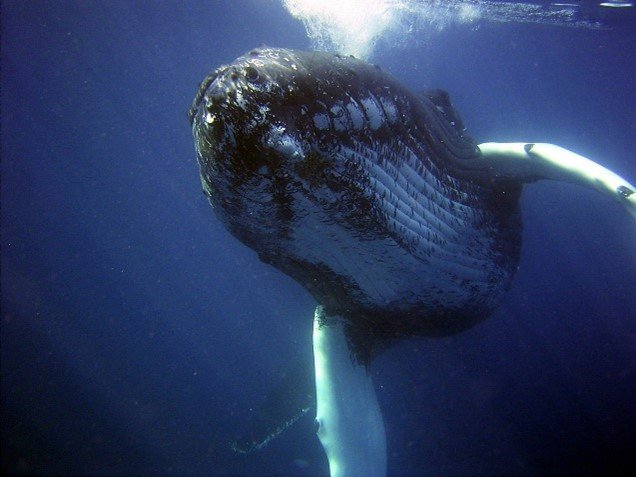Can Creatures of the Deep Help Track Forever Chemicals in Our Oceans?
Published October 24, 2024

From the tropics to the poles, whales glide through the deep, dark oceans, silently looking for their next meal. Some whales use teeth to eat their prey (although they often swallow their food whole). But 14 whale species, including blue whales and humpbacks, use baleen plates instead. Baleen are flexible, bristly plates made of keratin, a protein also found in fingernails, horns and hooves. Hundreds of keratin plates grow down in vertical rows from a whale’s upper jaw instead of teeth. Whales, the largest animals in the world, open their vast mouths underwater to feed. They pull in shrimp-like krill, plankton, and small fish, which get stuck in the tangled baleen plates. The whale’s tongue wears the plates down over time, but they continue to grow.
Baleen plates, like tree rings, indicate how whales adapt as their environment changes. The keratin protein in the baleen has a unique structure that reacts to changes in the environment, such as temperature and the presence of different molecules in the water. Scientists can use baleen tissue to track where a whale goes, what it eats, hormonal changes, and exposure to pollution.
The Scientific Question
EPA researchers Anna Robuck, Michaela Cashman, and Mark Cantwell (retired), in an effort led by Matt Savoca, a post-doctoral researcher at Stanford University, wondered if they could use whale baleen to better track how per- and polyfluoroalkyl substances (PFAS) travel in marine food webs. PFAS, also known as “forever chemicals,” are widely used, long-lasting chemicals that break down very slowly over time. PFAS are found in water, air, fish and soil across the nation and the globe.
Researchers know some PFAS bioaccumulate and can be biomagnified through the food chain. While whales are at the top of the aquatic food chain, they remain something of a mystery. Unlike other animals, researchers cannot easily access them for samples because of their size and oceanic habitat.
The researchers wanted to find out if PFAS can be detected in whale baleen and whether the amounts were the same throughout the baleen plate.
“We also wanted to know if PFAS levels were similar in different parts of the whale—for example, baleen compared to skin, blubber, liver, and gum tissues,” EPA scientist Anna Robuck said. “Three of the whale species we looked at had never been tested for PFAS contamination before. Two of those, the blue whale and North Atlantic right whale, are internationally endangered species.”
What They Discovered
“We collected 220 samples from 18 baleen plates of six different whale species that were already deceased. We detected higher levels of PFAS there than we found in other types of whale tissue, such as blubber and skin,” EPA researcher Michaela Cashman said.
The scientists found measurable PFAS in all six whale species they studied. PFAS have been found in other tissues that contain keratin, like feathers and human hair, but this is the first study to find these contaminants in baleen. The scientists can look at different locations on a baleen plate to find out how much PFAS a whale was exposed to over time.
Worldly Whales
The size, ease of storage, longitudinal growth and keratin properties of baleen make it a valuable resource for monitoring PFAS in the environment. Unlike wet tissues, baleen can be stored at room temperature without chemicals or fixatives. This means that baleen in museums, whale stranding networks and private collections could provide a window into where and when PFAS first started appearing in marine ecosystems.
Whales are key organisms in marine ecosystems worldwide. It is important to understand how whales are responding to the growing human impact on their environment. This study provides more information about how and where the long-lived PFAS chemicals can accumulate over time in our world’s oceans and could help determine how to better protect marine life.
This article was written by EPA’s Melissa Payne.
Learn more about the science:
Per- and Polyfluoroalkyl Substances (PFAS) | US EPA
“Whale Baleen for Monitoring Per- and Polyfluoroalkyl Substances (PFAS) in Marine Environments,” Environmental Science and Technology.
